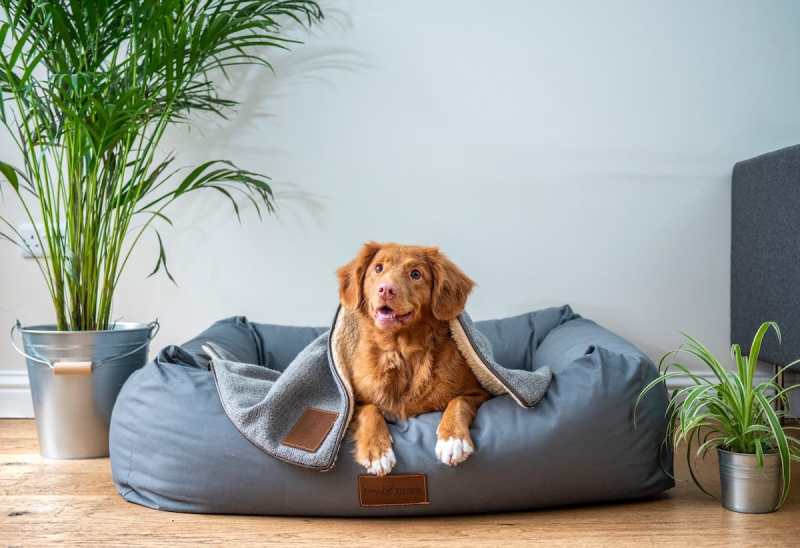Best Dog Friendly Garden Plants – Poinsettias, holly, conifers and other seasonal plants make great home decorations or fun holiday gifts like cookies and stockings. However, these and other living plants that are often used during the holidays pose some risks to curious pets who may eat leaves or flowers or drink standing water. And while we don’t want to discourage you from using live plants to decorate your hallways, you should know which plants are safe for pets, suitable for homes with lots of feathers, and which plants to avoid.
We asked The Sill’s botanists for advice on pet-safe Christmas plants and came up with some of the season’s most popular varieties. These recommended plants still provide the color and charm that only live plants can bring to the long and often dark days of winter without endangering pets. Below is a quick summary for you to share and delve into the whys and wherefores of each plant. Check out The Sill’s entire collection of pet-friendly plants and learn more about their pet-friendly subscription boxes.
Best Dog Friendly Garden Plants

Why do these “no” plants cause problems for your pet? Here’s why and what it means to change your pet’s safe plant during the holidays, as well as tips for caring for your pet’s perfect new plants. (Note: To order Pet Safe Change directly from The Sill, just click on the name of each plant.)
How To Grow Grass With Dogs: 7 Simple Solutions |
The poinsettia plant (Euphorbia pulcherrima) has a pungent milky sap that, if swallowed, can irritate the mouth and stomach and sometimes cause vomiting. While it is not the most poisonous plant threat to pets, it is not the greatest threat either! There are other options entirely.
Bursts with bright pink or red flowers at Christmas. Although it can cause stomach upset when eaten in large quantities, it is generally not healthy for curious pets.
This hardy epiphytic succulent plant needs bright light and high humidity to develop its full potential. A sunny window away from the heating source is sufficient. Do not water too much; Check if water is needed by lifting the pot. When it feels light, water it.
) Oils from trees and needles can irritate pets if ingested. In addition, the water in the tree trunk may contain oil as well as filtered chemicals used to grow the tree. Other conifers, including fir and spruce, have similar risks.
Landscaping For Dogs
) is a slow-growing plant when grown indoors, it does not grow more than 30 cm per year until it reaches a height of 3 m. We don’t say it’s a personal exchange, but it’s a good choice for families with pets that are prone to mischief.
The Majesty tree is known as the spirit tree. It may take a few tries to find the right spot, but this plant usually grows well in areas with lots of light. Provide plenty of water regularly and have a spray bottle ready to spray several times a week.
) contains lycorine and other toxins that can cause vomiting, diarrhea, loss of appetite, abdominal pain, coma and tremors in dogs and cats. It is said that the bulbs of this plant are more poisonous than the flowers and stems.
:max_bytes(150000):strip_icc()/GettyImages-1040976344-c127652a743c4c66ab94edab2c2d099d.jpg?strip=all)
Phalaenopsis orchids have the delicate blooms, rich colors, and Victorian beauty of an amaryllis plant, without the side effects of being eaten by pets. Plus, they can bloom for months and come in a variety of colors, so there’s likely to be one to match every room in the house.
Pet Friendly Plants
Phalaenopsis orchids prefer bright, indirect light. The east window is st; Western or southern light is fine as long as it is not direct. If the bark or moss feels dry and the pot is light in color, water your orchid well (until the water flows through the holes in the bottom of the pot).
) has spines that often prevent many livestock from consuming them in large enough quantities to cause significant damage. However, eating large amounts of leaves or berries can cause gastrointestinal symptoms such as vomiting and diarrhea.
It has beautiful, double-veined leaves that, while we don’t claim to be “perfect” unlike holly, we have vibrant leaves from the start, which is what we strive for here in the dark days winter if you only want. to be beautiful.
It’s not an easy houseplant to grow, but you can survive with a few tricks: Provide medium to bright indirect light; Water only when the top 1-2 layers of soil feel dry. Keep the humidity high to keep the leaves clean – mist regularly or place on a tray of pebbles. It’s very easy!
The 10 Most Poisonous Plants For Dogs And Cats
) is poisonous to dogs and cats (whole plant). Eating just a few leaves can cause vomiting and diarrhea, weakness, difficulty walking, coma, tremors or confusion, and loss of appetite. The long-term effects can be dangerous.
The peacock tree (Calathea kokoyana) has long green leaves, which are dark green on top and dark purple on the bottom. We love that it has the height, girth and bright color of a bush azalea, but is safe for pets and thrives indoors without much maintenance.
Say it once, twice, three times – this plant loves moisture. Humidity around 60% causes frizzy hair. Place in a tray full of pebbles in a bright place away from heat sources. Better yet, place the potted plant in the shower and run warm water to create a steamy shower. They will love you for it!
:max_bytes(150000):strip_icc()/safe-houseplants-for-pets-4588752-FINAL-6e6ebfe61c894bf2a12fa48e5b0e7987.png?strip=all)
Send us your frequently asked questions about good houseplants to Paris Lalicata, Community Assistant and Director of Plant Education at The Sill. Here is his advice to help you succeed. For more information, check out The Sill blog.
Safe Plants For Dogs You Can Add To The Garden Right Now
Answer: The palm tree is a pet-friendly ground plant that can grow up to 8-10 feet tall under the right indoor conditions.
Answer: Examples of pet-friendly plants that tolerate low light levels include bird ferns, house palms, Calathea and Peperomia species.
Answer: A good non-toxic plant is the phalaenopsis orchid. Some non-toxic plants such as Peperomia or Calathea can bloom indoors in good conditions, but they are sold mainly as foliage plants rather than flowering plants.
Answer: Christmas cacti (Schluggera) are pet friendly and there are some non-toxic species for Christmas decorations. Calatheas are also a good choice because their painted leaves are so beautiful that they can add a pop of color to any decor. Instead of poinsettias, African violets, pandanus and roses also work.
Plants Poisonous To Dogs: 10 Plants Toxic To Pups
Answer: Plants are only poisonous to animals when they are eaten. If there are already poisonous plants in your home, keep them out of reach by using things like wall/ceiling hooks, plant stands, etc. And if you really want a conifer Christmas tree, consider a small tree that you can put outside. Access to pets.
It is important to remember that not all plants are equally toxic to pets. Plant toxicity to pets that eat leaves or flowers can range from “may cause stomach upset” to more serious consequences, depending on the plant. However, when it comes to pets, it’s never wrong to be extra careful! From maintaining boundaries to protecting your plants, here’s our advice on making sure your garden is dog-friendly.
Gardens can be beautiful, stimulating places for dogs. But dogs can also cause damage by digging up plants and urinating on lawns.

Gardens also pose dangers – some plants can be poisonous to dogs and there are other dangers too, from toxic chemicals to sharp objects.
Discover The Best Pet Friendly Neighborhoods In Austin, Tx For You And Your Furry Friends
There are many things you can do to make sure you live in harmony with your four-legged friend, including planting non-toxic plants, creating designated areas for your dog, and keeping your yard safe.
By creating different paths in the garden, such as: B. clearly defined paths and designated places to play or dig, your dog’s activity is encouraged. The variety of surfaces can be stimulating underfoot and plants such as salix and ornamental grass dance and vibrate, providing entertainment.
Aggressive dogs can damage small trees or trees with thin trunks by digging or running over them. Plant large perennials and choose (avoid) hardy plants like nepeta, astilbe and hardy geraniums.
The species can be poisonous to dogs and, confusingly, goes by the common name of geranium. Use hardy shrubs like honeysuckle or wild roses as a permanent frame.
How To Choose The Right Type Of Grass And Plants For A Dog Friendly Garden?
Many garden plants are poisonous to dogs. These include chrysanthemum, aconite, buttercup, daffodil, daphne, delphinium, foxglove, hydrangea, oak, tomato, wisteria and yew (Taxus baccata). If you notice worrisome symptoms and suspect that your dog has eaten part of the plant, take your pet to the vet. Watch our video on plants that are poisonous to dogs.
Dogs can damage lawns and borders. Therefore, use sand or bark to create a designated area for playing or digging. To prevent dogs from straying beyond your boundaries, you can make paths through them or create a clear boundary, such as a low box fence. Raised beds are also a good option.
You can still have a beautiful garden if you


